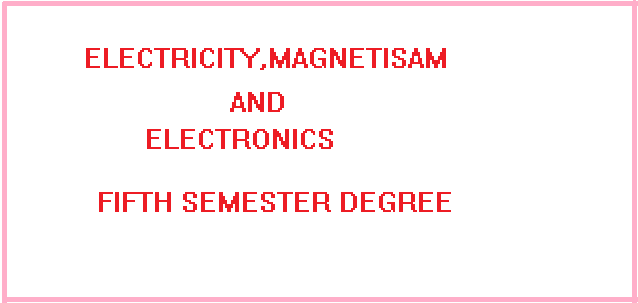Course outcomes:
On successful completion of this course, the students will be able to:
1. Understand the Gauss law and its application to obtain electric field in different cases and formulate the relationship between electric displacement vector, electric polarization, Susceptibility, Permittivity and Dielectric constant.
2. Distinguish between the magnetic effect of electric current and electromagnetic induction and apply the related laws in appropriate circumstances.
3. Understand Biot and Savart’s law and Ampere’s circuital law to describe and explain the generation of magnetic fields by electrical currents.
4. Develop an understanding on the unification of electric and magnetic fields and Maxwell’s equations governing electromagnetic waves.
5. Phenomenon of resonance in LCR AC-circuits, sharpness of resonance, Q- factor, Power factor and the comparative study of series and parallel resonant circuits.
6. Describe the operation of p-n junction diodes, zener diodes, light emitting diodes and transistors
7. Understand the operation of basic logic gates and universal gates and their truth tables.
UNIT-I
Contents
1. Electrostatics
Gauss’s law-Statement and its proof, Electric field intensity due to (i) uniformly charged solid sphere and (ii) an infinite conducting sheet of charge, Deduction of Coulomb’s law from Gauss law, Electrical potential–Equipotential surfaces, Potential due to a (i) dipole (ii)uniformly charged sphere
2.Dielectrics
Dielectrics-Polar and Non-polar dielectrics- Effect of electric field on dielectrics, Dielectric strength, Capacitance of a parallel plate condenser with dielectric slab between the plates, Electric displacement D, electric polarization P, Relation between D, E and P, Dielectric constant and electric susceptibility.
UNIT-II
3.Magnetostatics
Biot-Savart’s law and its applications: (i) circular loop and (ii) solenoid, Divergence and curl of magnetic field, Ampere’s Circuital Law and its application to Solenoid, Hall effect, determination of Hall coefficient and applications.
4.Electromagnetic Induction
Faraday’s laws of electromagnetic induction, Lenz’s law, Self induction and Mutual induction, Self inductance of a long solenoid, Mutual inductance of two coils, Energy stored in magnetic field, Eddy currents and Electromagnetic damping
UNIT-III
5. Alternating currents
Alternating current – Relation between current and voltage in LR and CR circuits, Phasor and Vector diagrams, LCR series and parallel resonant circuit, Q –factor, Power in ac circuits, Power factor.
6.Electromagnetic waves-Maxwell’s equations
Idea of displacement current, Maxwell’s equations-Derivation, Maxwell’s wave equation(with derivation), Transverse nature of electromagnetic waves, Poynting theorem (Statement and proof)
UNIT-IV
7. Basic Electronic devices
PN junction diode, Zener diode and Light Emitting Diode (LED) and their I-V characteristics, Zener diode as a regulator- Transistors and its operation, CB, CE and CC configurations, Input and output characteristics of a transistor in CE mode, Relation between alpha, beta and gamma; Hybrid parameters, Determination of hybrid parameters from transistor characteristics; Transistor as an amplifier.
UNIT-V:
8. Digital Electronics
Number systems, Conversion of binary to decimal system and vice versa, Binary addition & Binary subtraction (1’s and 2’s complement methods), Laws of Boolean algebra, DeMorgan’s laws-Statements and Proofs, Basic logic gates, NAND and NOR as universal gates, Exclusive-OR gate, Half adder and Full adder circuits.
ELECTRICITY, MAGNETISM AND ELECTRONICS MATERIAL-1 DOWNLOAD CLICK HERE
ELECTRICITY, MAGNETISM AND ELECTRONICS QUESTION PAPER 2022 DOWNLOAD CLICK HERE

